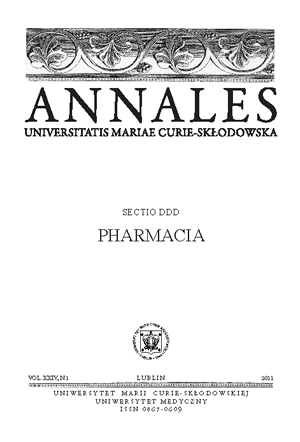Historia aptekarstwa w Bełżycach, część I – historia aptekarstwa w latach 1874-1945
Słowa kluczowe:
historia aptekarstwa, BełżyceAbstrakt
Powyższy artykuł jest pierwszym z cyklu przeznaczonym do Annales, a odnoszącym się do historii aptekarstwa i szpitalnictwa oraz dziejów nauczania farmacji i medycyny w regionie lubelskim. Podjęto się próby odtworzenia dziejów aptekarstwa Bełżyc od momentu powstania miasta, a właściwie od momentu założenia pierwszej apteki w 1874 r., aż do czasów współczesnych. Ten artykuł jest pierwszą częścią opracowania.
Z dokumentów zgromadzonych w zasobach Archiwum Lubelskiego dowiadujemy się, że aptekę w Bełżycach założył w 1874 r. Lucjan Osipowicz Czerwiński. Jego apteka pierwotnie znajdowała się w nieistniejącym dziś budynku koło kościoła (obecnie ulica Partyzancka).
Otwarcia tej placówki dokonano w obecności specjalnej komisji, którą tworzyli lubelski lekarz powiatowy, asesor farmacji i wójt. Na tę okoliczność sporządzony został specjalny, obszerny protokół, zawierający informacje na temat wyglądu zewnętrznego apteki, rozmieszczenia pomieszczeń i wystroju wewnątrz.
W 1913 r. L. Czerwiński sprzedał swoją własność Adamowi Tomaszewskiemu, który prowadził ją do 1919 r. W maju 1914 r. A. Tomaszewski przeniósł aptekę do kamienicy kupca Kjemnica znajdującej się w centrum miasta, tj. na rogu ulicy Kazimierskiej i Rynku. Adam Tomaszewski w historii miasta zaznaczył się jako dobry społecznik i organizator.
W okresie międzywojennym w aptece pracowali: Michał Jabłonowski, Henryk Kowalewski, Wiktor Leśnikowski i Anschel Lerner.
W czasie II wojny światowej, apteka stała się świadkiem tragicznych wydarzeń. Aresztowano Anschela Lernera, oraz eksterminowano Żydów bełżyckiego getta, a także rozstrzelano w publicznej egzekucji 23 Polaków.
Bibliografia
1. Zafón C.:The Shadow of the Wind. Penguin, 2004.
2. Studia z dziejów Bełżyc, 299, Bełżyce 2006.
3. Archiwum Państwowe w Lublinie (APL), Rząd Gubernialny Lubelski (RGL), Wydział Lekarski, (L), 14, 19, 1874.
4. APL, RGL, L II, 14, 3, 1874.
5. APL, RGL, L II, 14, 9, 1874.
6. APL, RGL, L II, 14, 19, 1874.
7. APL, RGL, L II, 14, 20, 1874.
8. Kronika Bełżyc, Izba Pamięci w remizie straży pożarnej.
9. APL, RGL, L II, 14, 19, 1914.
10. APL, RGL, L II, 43, 19,1914.
11. Wrobel A., Konstankiewicz A., Obel E.: Apteka przy ulicy Krakowskie Przedmieście 29 (dawniej 146) przedwojenna własność Antoniego Steckiego, Gustawa Haberlau i Adama Tomaszewskiego. Pamiętnik Farmaceutyczny Wileński1/97,39, Lublin1997.
12. Kalendarze Farmaceutyczne: 154, 1929; 328; 1934; 321, 1936; 387, 1939.
13. Księga Parafialna Parafii pod Wezwaniem Nawrócenia św. Pawła w Bełżycach, 342, 1915-1930.
14. Kalendarze Farmaceutyczne: 125, 1929; 375,1930; 330, 1932; 350,1936; 415, 1939.
15. Kalendarze Farmaceutyczne: 164, 1928; 428, 1930; 383, 1932.
16. Kalendarze Farmaceutyczne: 396, 1934; 410, 1936; 19, 1939.
17. APL, Urząd Wojewódzki Lubelski, Wydział Pracy, Opieki i Zdrowia [1919-1939], 532,19.
18. Jadczak St.: Bełżyce – monografia miasta i gminy, 24, Bełżyce 2002.
Pobrania
Opublikowane
Numer
Dział
Licencja
Prawa autorskie (c) 2011 Autorzy

Praca jest udostępniana na licencji Creative Commons Attribution-NonCommercial-NoDerivatives 3.0 Unported License.


